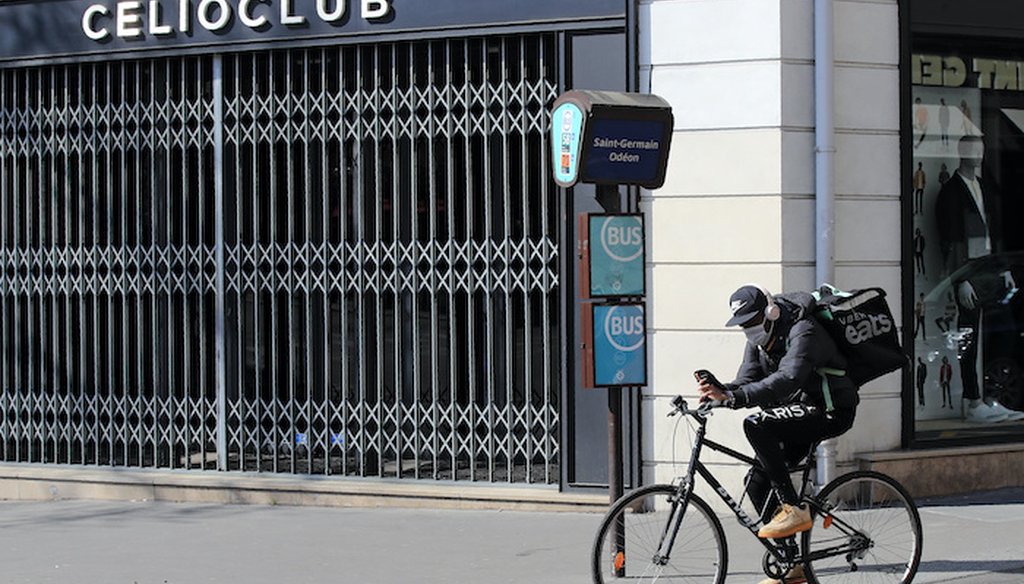Stand up for the facts!
Our only agenda is to publish the truth so you can be an informed participant in democracy.
We need your help.
I would like to contribute

A man of a food delivery service rides his bike in Paris, Thursday, March 19, 2020. (Associated Press)
If Your Time is short
-
Ordering takeout is largely considered safe amid the COVID-19 pandemic but experts say it’s important to practice good food handling, to limit interaction with workers, and to wash hands before and after eating.
Restaurant dining rooms across the U.S. are closed due to COVID-19, but many are offering more takeout and delivery service than ever before.
The option to savor your favorite dish from your neighborhood haunt may feel like a silver lining during this time of stay-home directives. But one nagging question may spoil your appetite: Is it really safe?
We finally have some good news. Here’s what we found out.
No evidence of COVID-19 transmission through food
Currently, there is no evidence that food or food containers and packaging are associated with COVID-19 transmission, according to both the Centers for Disease Control and Prevention and the Food and Drug Administration.
"It may be possible that a person can get COVID-19 by touching a surface or object that has the virus on it and then touching their mouth, nose, or possibly their eyes, but this is not thought to be the main way the virus spreads," the FDA says on its website. "If you are concerned about contamination of food or food packaging, wash your hands after handling food packaging, after removing food from the packaging, before you prepare food for eating and before you eat.
Sign up for PolitiFact texts
There are a few reasons why food risk is low.
First, restaurants and chefs are already accustomed to following safety standards designed to prevent illnesses, such as frequently cleaning surfaces and equipment and cooking food to certain temperatures.
The National Restaurant Association, an organization that represents around 500,000 restaurants in the U.S., told PolitiFact that the industry continues to follow food safety guidance, which includes personal hygiene, sanitation and workplace safety, and monitors COVID-19 guidance from the FDA, CDC and the EPA.
Larry Lynch, the organization’s senior vice president of science and industry, said its member restaurants are following all the guidelines they always have, as well as implementing new strategies to keep workers and customers safe during the pandemic.
"It comes down to extra sanitation and anything you're handing out to a driver being double-sealed and closed properly so the consumer has the confidence that the handling has been limited," Lynch said. "Just the typical sanitation practices you do in the kitchen, but pushing a little deeper."
Examples of this include ensuring cash transactions are handled by someone not handling food, he said. Regular hand-washing and surface washing practices are increased. Managers are on high alert, paying attention to their employees and getting them out of the restaurant if they start to feel sick.
Meanwhile, preliminary research shows that unlike foodborne viruses like norovirus, which can live for weeks on surfaces and survive freezing and heating, COVID-19 cannot survive that long.
Related: Novel coronavirus could live up to 3 days, depending on the surface
"We know much less about coronavirus, but the best studies suggest that it probably lives hours or a few days at most, less than most common foodborne germs," the Center for Science in the Public Interest says. "The public health officials who track the disease haven’t found any examples of someone catching COVID-19 from food. We’re still learning about this virus, but it’s safe to say the main risk people should be focused on is avoiding contact with an infected person, not food."
Benjamin Chapman, a professor and food safety specialist at North Carolina State University, told PolitiFact that all current evidence and data points toward person-to-person transmission as the greatest risk factor for COVID-19.
"We don’t have any epidemiological indication, evidence or data that food or food packaging has been an actual transmission route for getting sick, so food itself and the packaging are very, very low risk," Chapman wrote in an email.
Although the risk of human interaction isn’t eliminated with takeout and delivery, it is being mitigated.
Several delivery services and restaurants are trying to minimize contact between workers and customers by implementing curbside pickup and emphasizing electronic payments so meals can be dropped off on doorsteps.
Experts say handwashing before, during and after any interaction, like picking up a to-go order or getting groceries, is an important and effective way to reduce the risk of infection.
While there’s a very small chance that the virus arrives in your home on food packaging, Chapman says, practices that are normally encouraged for good food safety — like cleaning and sanitizing during food preparation and disinfecting countertops — are effective.
Overall, the greatest COVID-19 transmission risk comes from direct interaction with other people. Ordering pickup and delivery meals is largely considered safe, but experts say you should still take extra precautions and practice good food safety.
Health officials maintain that frequent hand washing, social distancing and not touching your face are still the best ways to prevent the spread of the virus and reduce the chance of getting infected.
Our Sources
US Food and Drug Administration, Food Safety and the Coronavirus Disease 2019 (COVID-19), March 27, 2020
US Food and Drug Administration, Coronavirus Disease 2019 (COVID-19) Frequently Asked Questions, March 30, 2020
Center for Science in the Public Interest, Frequently Asked Questions about COVID-19 and Food, Accessed March 31, 2020
Eater, It’s No Longer Responsible to Dine Out at Restaurants, but What About Delivery and Takeout?, March 18, 2020
Forbes, Is Eating Takeout Food Safe During The Coronavirus Pandemic?, March 25, 2020
Live Science, Can you catch COVID-19 from food?, March 24, 2020
Email interview, Benjamin Chapman professor and food safety specialist at North Carolina State University, March 31, 2020
Phone interview, Larry Lynch senior vice president of science and industry at the National Restaurant Association, April 1, 2020






































